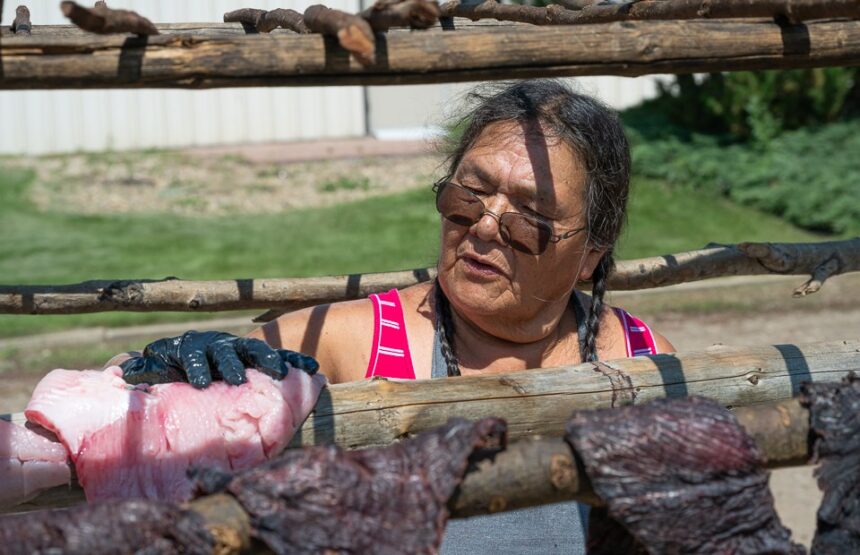The late summer sun filters through a canopy of birch trees as Doris Paul, a 67-year-old Cree Elder from Sturgeon Lake First Nation, threads thin strips of whitefish onto a wooden rack. Around her, a dozen community members of all ages gather in a semi-circle, watching intently as she demonstrates a food preservation technique that sustained her ancestors through harsh prairie winters.
“My grandmother showed me how to do this when I was just seven,” Paul tells me, her weathered hands moving with practiced precision. “She would say: ‘Watch carefully, this knowledge is your birthright.'”
I’ve traveled to this traditional territory north of Prince Albert to document a three-day workshop centered around traditional food preservation methods being revitalized through the “Tipi Teachings” program. The initiative, funded through a partnership between the Saskatchewan Indigenous Cultural Centre and Health Canada’s Indigenous Healthy Living Program, represents a growing movement to reclaim food sovereignty across First Nations communities.
Inside a 20-foot tipi erected specifically for the workshop, participants learn to smoke fish, dry berries, and prepare pemmican—a nutrient-dense mixture of dried meat, fat, and berries that once sustained Plains First Nations people during long journeys. What strikes me most is how these ancient practices speak directly to contemporary concerns about food security, nutrition, and cultural identity.
“When we preserve food in our traditional ways, we’re not just addressing hunger—we’re nourishing our spirits and minds too,” explains Jason Waditaka, a program coordinator with the Indigenous Food Sovereignty Network. “These methods produce no waste, require no electricity, and create foods that maintain their nutritional value for months.”
The statistics underscore why such knowledge matters. According to a 2022 report from Statistics Canada, food insecurity affects 31% of Indigenous households in Canada—more than double the national average. In northern communities, where a single head of lettuce can cost upwards of $8, traditional food systems represent not just cultural continuity but economic necessity.
Participant Sarah Musqua, 32, writes notes as Paul explains how different smoking woods impart distinct flavors. As a young mother of three, Musqua sees these techniques as practical solutions for her family’s future.
“My kids’ school lunches cost us almost $200 a month,” she tells me during a break. “Learning to prepare and preserve traditional foods means I can feed my family nutritious meals that connect them to their heritage while stretching our budget further.”
What makes the Tipi Teachings program particularly effective is its holistic approach. Food preservation isn’t taught in isolation but woven into broader cultural contexts. The tipi itself serves as both classroom and metaphor—its poles representing values like respect, humility, and sharing that guide traditional food practices.
“In our worldview, food preservation was never just a technique,” explains Elder Thomas Whitecalf, who oversees the spiritual aspects of the workshop. “It was part of a relationship with the land. When we hunted, gathered, or fished, we took only what we needed and used every part. Preservation was how we honored that relationship through the changing seasons.”
The workshop participants range from teenagers to Elders in their seventies, creating a multigenerational learning environment that mirrors traditional knowledge transmission. Fifteen-year-old Dakota Littlechief deftly slices bison meat for drying while her grandmother offers quiet guidance.
“Before colonization, our communities never experienced the kind of food insecurity we see today,” notes Dr. Priscilla Settee, Indigenous studies professor at the University of Saskatchewan, whose research on Indigenous food systems has informed similar initiatives. “The disruption of traditional food practices through residential schools, forced relocation, and environmental degradation created nutritional and cultural deficits we’re still addressing.”
Indeed, research published in the Canadian Journal of Public Health has demonstrated correlations between access to traditional foods and improved health outcomes in Indigenous communities, including lower rates of diabetes and heart disease.
As afternoon turns to evening, participants gather around a fire to share a meal prepared using the preservation techniques they’ve learned. Plates are filled with smoked whitefish, dried saskatoon berries, and wild rice harvested from nearby waterways. The conversation flows between Cree and English, with frequent bursts of laughter.
For Fred Sasakamoose, 42, who traveled from Ahtahkakoop Cree Nation to attend, the workshop represents a chance to heal intergenerational wounds.
“My father was forbidden from speaking his language or practicing our food ways in residential school,” he says, his voice softening. “He passed away from diabetes complications five years ago. I’m here because I want my children to have what was taken from him—knowledge that kept our people healthy for thousands of years.”
The final day of the workshop focuses on teaching participants how to incorporate these traditional methods into contemporary life. Some discussions center on adapting preservation techniques for apartment living, while others address the challenges of harvesting traditional foods in areas affected by industrial development.
“We’re not suggesting everyone can or should live entirely off traditional foods,” explains workshop facilitator Karen Carriere. “But even incorporating some of these methods and foods can improve nutrition, reduce dependence on expensive imported foods, and strengthen cultural identity.”
As I prepare to leave, I watch participants carefully packing dried herbs, smoked fish, and berries to take home. They exchange phone numbers and make plans to harvest together in the coming seasons. What began as a food preservation workshop has clearly evolved into something more profound—a community rebuilding itself through shared knowledge and purpose.
Elder Paul catches my eye as I gather my notes. “Make sure you write that this isn’t about going backward,” she says firmly. “Our ancestors were innovators who developed sophisticated systems for living well on this land. Now we’re bringing that innovation forward—because our future depends on it.”
When I call a week later to follow up, Musqua tells me she’s already hosted a small preservation workshop in her community. “Seven families came,” she says proudly. “We dried chokecherries together while our kids played. It felt like something important was being restored—not just food, but community.”
In a world increasingly concerned with food security and sustainability, these ancient practices offer wisdom that extends far beyond Indigenous communities. Like the carefully preserved foods emerging from the tipi workshop, such knowledge sustains not just bodies, but the intricate connections between people, culture, and the land that nurtures us all.






